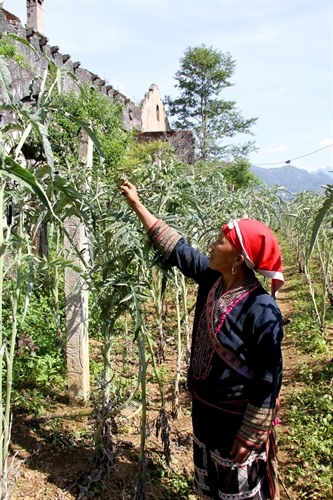 Society
Society

Artichokes produced in Lào Cai Province contain a high concentration of cynarin, which can assist in lowering cholesterol and breaking down unwanted fat. Farmers in the region are cashing in on increased demand.
 |
| A woman from the northern province of Lào Cai inspects artichokes in her garden. — VNA/VNS Photo |
LÀO CAI — Artichokes are native to the Mediterranean region and can be found throughout Europe, the Middle East, and the
They were first brought to Việt
Artichokes grown in the Sa Pa District of Lào Cai Province contain a high concentration of cynarin (artichoke concentrate) which can reduce cholesterol production by the liver and expel cholesterol from the liver and gallbladder. This process then stimulates liver bile production and distribution, which in turn helps in the breakdown of fat.
During the 1990’s artichokes were so common in Sa Pa that local people would regularly collect the leaves, flowers or roots for personal use. The over exploitation of artichokes without proper re-cultivation eventually led to the plants becoming near-extinct in the region.
By 1998 deputy general director of Traphaco Joint Stocks Company Nguyễn Huy Văn declared that the company intended on restoring artichoke farms to
Traphaco asked the institute to import artichoke seeds from
“We finally concentrated on revitalizing artichoke production in
The company shared artichoke farming techniques with local farmers, helping them to grow the fruit, and committed to purchasing all output.
Văn pointed out that Việt Nam has around 4,000 herbal remedies, meaning a valuable market could be created from utilising local knowledge in the field.
“Currently, traditional medicine is not only limited to traditional methods of herbal medicine production but also the application of advanced science and technology from product development and plant care to harvest, processing and packaging,” Văn said.
Thào A Từ, a farmer from Suối Hồ Hamlet, Sa Pa District said that since 2011, he has shifted more than 3,000 sq.m of land from rice production to artichokes, earning him around VNĐ70 million (US$ 3,000) annually– six times more than he would have earned from rice cultivation.
“Thanks to artichoke farming, I can afford to send my two children to school and build a new house,” Từ said.
Another farmer Thào A Cáng, from Suối Hồ Hamlet, Sa Pả Commune, Sa Pa District said that before co-operation with Traphaco his family attempted to grow artichokes, but the trees wouldn’t adapt to the climate.
Cáng went on to say that after Traphaco shared their growing methods and sent technicians to his farm to advise him, he could produce seedlings in abundance and even grow other crops in his artichoke garden to bring in more money.
“I have worked with the company for eight years. I was the first farmer who grew artichokes in my hamlet,” Cáng said, adding that he later taught other farmers in the area to develop their artichoke farms.
Director of
One hectare of artichokes could generate around VNĐ 300 million ($13,000) annually, and farmers could earn a yearly profit of up to VNĐ 150 million per hectare.
“In artichoke farming zones, farmers have better incomes than others in the province,” Tuấn said.
Tuấn said that thanks to the WHO’s guidelines on good agricultural and collection practices (GACP-WHO), production of artichokes in the province has noticeably increased.
“Artichokes can grow well when combining local weather with improved cultivation from local farmers,” Tuấn said.
He also said that the mountainous
Besides artichokes, Traphaco are also co-operating with pharmaceutical companies to pilot growing other crops that could be used as herbal remedies – VNS




